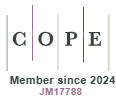Are calcium channel blockers related to lung cancer?
DOI:
https://doi.org/10.33393/dti.2023.2573Keywords:
Dyslipidemia, Family history, Risk factorsAbstract
Background: Calcium channel blocker (CCB) is a common antihypertensive agent for the treatment of hypertension. There are inconsistent data of an association of CCB and lung cancer in the literature. This study aimed to evaluate this association by a case-control design.
Methods: The inclusion criteria were adult patients 18 years or over, diagnosed with hypertension, lung cancer or pulmonary tuberculosis, and presenting with one of the suggestive symptoms of lung cancer. Those who were pregnant or had a diagnosis of lung cancer or pulmonary tuberculosis prior to the diagnosis of hypertension were excluded. Diagnosis of lung cancer was made pathologically, while tuberculosis was made by positive acid-fast bacilli on sputum examination, sputum culture positive for Mycobacterium tuberculosis, or polymerase chain reaction positive for M. tuberculosis with a chest x-ray compatible with tuberculosis. Cases were those diagnosed with lung cancer, while controls were those diagnosed with tuberculosis. Factors associated with lung cancer were calculated by logistic regression analysis.
Results: There were 178 patients who met the study criteria. Of those, 69 patients (38.8%) were in the case group. The lung cancer group had EGFR gene mutation in 21 patients (52.5%) and adenocarcinoma was the most common cell type of lung cancer (55 patients; 79.7%). There were two factors independently associated with lung cancer including dyslipidemia and family history of lung cancer.
Conclusions: CCB was not associated with lung cancer in patients with hypertension but dyslipidemia and family history of lung cancer were independently associated with lung cancer in this setting.
References
- Mills KT, Stefanescu A, He J. The global epidemiology of hypertension. Nat Rev Nephrol. 2020;16(4):223-237. https://doi.org/10.1038/s41581-019-0244-2 PMID:32024986 DOI: https://doi.org/10.1038/s41581-019-0244-2
- Zhou B, Carrillo-Larco RM, Danaei G, et al; NCD Risk Factor Collaboration (NCD-RisC). Worldwide trends in hypertension prevalence and progress in treatment and control from 1990 to 2019: a pooled analysis of 1201 population-representative studies with 104 million participants. Lancet. 2021;398(10304):957-980. https://doi.org/10.1016/S0140-6736(21)01330-1 PMID:34450083 DOI: https://doi.org/10.1016/S0140-6736(21)01330-1
- Chobanian AV, Bakris GL, Black HR, et al; National High Blood Pressure Education Program Coordinating Committee. The Seventh Report of the Joint National Committee on Prevention, Detection, Evaluation, and Treatment of High Blood Pressure: the JNC 7 report. JAMA. 2003;289(19):2560-2572. https://doi.org/10.1001/jama.289.19.2560 PMID:12748199 DOI: https://doi.org/10.1001/jama.289.19.2560
- Khamsai S, Mahawarakorn P, Limpawattana P, et al. Prevalence and factors correlated with hypertension secondary from obstructive sleep apnea. Multidiscip Respir Med. 2021;16(1):777. https://doi.org/10.4081/mrm.2021.777 PMID:34650797 DOI: https://doi.org/10.4081/mrm.2021.777
- Jeerasuwannakul B, Sawunyavisuth B, Khamsai S, Sawanyawisuth K. Prevalence and risk factors of proteinuria in patients with type 2 diabetes mellitus. Asia Pac J Sci Technol. 2021;26(04):APST-26-04-02: 1-5. https://doi.org/10.14456/apst.2021.32
- Manasirisuk P, Chainirun N, Tiamkao S, et al. Efficacy of generic atorvastatin in a real-world setting. Clin Pharmacol. 2021;13:45-51. https://doi.org/10.2147/CPAA.S285750 PMID:33707972 DOI: https://doi.org/10.2147/CPAA.S285750
- Soontornrungsun B, Khamsai S, Sawunyavisuth B, et al. Obstructive sleep apnea in patients with diabetes less than 40 years of age. Diabetes Metab Syndr. 2020;14(6):1859-1863. https://doi.org/10.1016/j.dsx.2020.09.008 PMID:32992217 DOI: https://doi.org/10.1016/j.dsx.2020.09.008
- Khamsai S, Chootrakool A, Limpawattana P, et al. Hypertensive crisis in patients with obstructive sleep apnea-induced hypertension. BMC Cardiovasc Disord. 2021;21(1):310. https://doi.org/10.1186/s12872-021-02119-x PMID:34162333 DOI: https://doi.org/10.1186/s12872-021-02119-x
- James PA, Oparil S, Carter BL, et al. 2014 evidence-based guideline for the management of high blood pressure in adults: report from the panel members appointed to the Eighth Joint National Committee (JNC 8). JAMA. 2014;311(5):507-520. https://doi.org/10.1001/jama.2013.284427 PMID:24352797 DOI: https://doi.org/10.1001/jama.2013.284427
- Pahor M, Guralnik JM, Salive ME, Corti MC, Carbonin P, Havlik RJ. Do calcium channel blockers increase the risk of cancer? Am J Hypertens. 1996;9(7):695-699. https://doi.org/10.1016/0895-7061(96)00186-0 PMID:8806983 DOI: https://doi.org/10.1016/0895-7061(96)00186-0
- Azoulay L, Assimes TL, Yin H, Bartels DB, Schiffrin EL, Suissa S. Long-term use of angiotensin receptor blockers and the risk of cancer. PLoS One. 2012;7(12):e50893. https://doi.org/10.1371/journal.pone.0050893 PMID:23251399 DOI: https://doi.org/10.1371/journal.pone.0050893
- Rotshild V, Azoulay L, Feldhamer I, et al. Calcium channel blockers and the risk for lung cancer: a population-based nested case-control study. Ann Pharmacother. 2019;53(5):445-452. https://doi.org/10.1177/1060028018814684 PMID:30442036 DOI: https://doi.org/10.1177/1060028018814684
- Rotshild V, Azoulay L, Zarifeh M, et al. The risk for lung cancer incidence with calcium channel blockers: a systematic review and meta-analysis of observational studies. Drug Saf. 2018;41(6):555-564. https://doi.org/10.1007/s40264-018-0644-4 PMID:29484611 DOI: https://doi.org/10.1007/s40264-018-0644-4
- Hole DJ, Gillis CR, McCallum IR, et al. Cancer risk of hypertensive patients taking calcium antagonists. J Hypertens. 1998;16(1):119-124. https://doi.org/10.1097/00004872-199816010-00017 PMID:9533425 DOI: https://doi.org/10.1097/00004872-199816010-00017
- Michels KB, Rosner BA, Walker AM, et al. Calcium channel blockers, cancer incidence, and cancer mortality in a cohort of U.S. women: the nurses’ health study. Cancer. 1998;83(9):2003-2007. https://doi.org/10.1002/(SICI)1097-0142(19981101)83:9<2003::AID-CNCR17>3.0.CO;2-3 PMID:9806660 DOI: https://doi.org/10.1002/(SICI)1097-0142(19981101)83:9<2003::AID-CNCR17>3.0.CO;2-3
- Yang R, Zhang Y, Liao X, Yao Y, Huang C, Liu L. The relationship between anti-hypertensive drugs and cancer: anxiety to be resolved in urgent. Front Pharmacol. 2020;11:610157. https://doi.org/10.3389/fphar.2020.610157 PMID:33381045 DOI: https://doi.org/10.3389/fphar.2020.610157
- Mason RP. Calcium channel blockers, apoptosis and cancer: is there a biologic relationship? J Am Coll Cardiol. 1999;34(7):1857-1866. https://doi.org/10.1016/S0735-1097(99)00447-7 PMID:10588195 DOI: https://doi.org/10.1016/S0735-1097(99)00447-7
- Jick H, Jick S, Derby LE, Vasilakis C, Myers MW, Meier CR. Calcium-channel blockers and risk of cancer. Lancet. 1997;349(9051):525-528. https://doi.org/10.1016/S0140-6736(97)80084-0 PMID:9048789 DOI: https://doi.org/10.1016/S0140-6736(97)80084-0
- Boo H-J, Min H-Y, Jang H-J, et al. The tobacco-specific carcinogen-operated calcium channel promotes lung tumorigenesis via IGF2 exocytosis in lung epithelial cells. Nat Commun. 2016;7(1):12961. https://doi.org/10.1038/ncomms12961 PMID:27666821 DOI: https://doi.org/10.1038/ncomms12961
- Carboni GL, Gao B, Nishizaki M, et al. CACNA2D2-mediated apoptosis in NSCLC cells is associated with alterations of the intracellular calcium signaling and disruption of mitochondria membrane integrity. Oncogene. 2003;22(4):615-626. https://doi.org/10.1038/sj.onc.1206134 PMID:12555074 DOI: https://doi.org/10.1038/sj.onc.1206134
- Li J, Lam ASM, Yau STY, Yiu KKL, Tsoi KKF. Antihypertensive treatments and risks of lung cancer: a large population-based cohort study in Hong Kong. BMC Cancer. 2021;21(1):1202. https://doi.org/10.1186/s12885-021-08971-6 PMID:34763668 DOI: https://doi.org/10.1186/s12885-021-08971-6
- Hao B, Yu M, Sang C, Bi B, Chen J. Dyslipidemia and non-small cell lung cancer risk in Chinese population: a case-control study. Lipids Health Dis. 2018;17(1):278. https://doi.org/10.1186/s12944-018-0925-z PMID:30522496 DOI: https://doi.org/10.1186/s12944-018-0925-z
- Su F, Grijalva V, Navab K, et al. HDL mimetics inhibit tumor development in both induced and spontaneous mouse models of colon cancer. Mol Cancer Ther. 2012;11(6):1311-1319. https://doi.org/10.1158/1535-7163.MCT-11-0905 PMID:22416044 DOI: https://doi.org/10.1158/1535-7163.MCT-11-0905
- Wolfe AR, Atkinson RL, Reddy JP, et al. High-density and very-low-density lipoprotein have opposing roles in regulating tumor-initiating cells and sensitivity to radiation in inflammatory breast cancer. Int J Radiat Oncol Biol Phys. 2015;91(5):1072-1080. https://doi.org/10.1016/j.ijrobp.2014.12.039 PMID:25832697 DOI: https://doi.org/10.1016/j.ijrobp.2014.12.039
- Lissowska J, Foretova L, Dabek J, et al. Family history and lung cancer risk: international multicentre case-control study in Eastern and Central Europe and meta-analyses. Cancer Causes Control. 2010;21(7):1091-1104. https://doi.org/10.1007/s10552-010-9537-2 PMID:20306329 DOI: https://doi.org/10.1007/s10552-010-9537-2
- Yin X, Chan CPY, Seow A, Yau W-P, Seow WJ. Association between family history and lung cancer risk among Chinese women in Singapore. Sci Rep. 2021;11(1):21862. https://doi.org/10.1038/s41598-021-00929-9 PMID:34750403 DOI: https://doi.org/10.1038/s41598-021-00929-9
- Kanwal M, Ding X-J, Cao Y. Familial risk for lung cancer. Oncol Lett. 2017;13(2):535-542. https://doi.org/10.3892/ol.2016.5518 PMID:28356926 DOI: https://doi.org/10.3892/ol.2016.5518
- Scragg R, Glover M. Parental and adolescent smoking: does the association vary with gender and ethnicity? N Z Med J. 2007;120(1267):U2862. PMID:18157188
- Salber EJ, MacMahon B. Cigarette smoking among high school students related to social class and parental smoking habits. Am J Public Health Nations Health. 1961;51(12):1780-1789. https://doi.org/10.2105/AJPH.51.12.1780 PMID:14496305 DOI: https://doi.org/10.2105/AJPH.51.12.1780
- Coté ML, Liu M, Bonassi S, et al. Increased risk of lung cancer in individuals with a family history of the disease: a pooled analysis from the International Lung Cancer Consortium. Eur J Cancer. 2012;48(13):1957-1968. https://doi.org/10.1016/j.ejca.2012.01.038 PMID:22436981 DOI: https://doi.org/10.1016/j.ejca.2012.01.038
- Yamamoto H, Higasa K, Sakaguchi M, et al. Novel germline mutation in the transmembrane domain of HER2 in familial lung adenocarcinomas. J Natl Cancer Inst. 2014;106(1):djt338. https://doi.org/10.1093/jnci/djt338 PMID:24317180 DOI: https://doi.org/10.1093/jnci/djt338
- Bell DW, Gore I, Okimoto RA, et al. Inherited susceptibility to lung cancer may be associated with the T790M drug resistance mutation in EGFR. Nat Genet. 2005;37(12):1315-1316. https://doi.org/10.1038/ng1671 PMID:16258541 DOI: https://doi.org/10.1038/ng1671
- Sawunyavisuth B, Ngamjarus C, Sawanyawisuth K. A meta-analysis to identify factors associated with CPAP machine purchasing in patients with obstructive sleep apnea. Biomed Rep. 2022;16(6):45. https://doi.org/10.3892/br.2022.1528 PMID:35620316 DOI: https://doi.org/10.3892/br.2022.1528
- Sanlung T, Sawanyawisuth K, Silaruks S, et al. Clinical characteristics and complications of obstructive sleep apnea in Srinagarind hospital. J Med Assoc Thai. 2020;103(1):36-39.
- Khamsai S, Kachenchart S, Sawunyavisuth B, et al. Prevalence and risk factors of obstructive sleep apnea in hypertensive emergency. J Emerg Trauma Shock. 2021;14(2):104-107. https://doi.org/10.4103/JETS.JETS_47_20 PMID:34321809 DOI: https://doi.org/10.4103/JETS.JETS_47_20
- Sawunyavisuth B, Ngamjarus C, Sawanyawisuth K. Any effective intervention to improve CPAP adherence in children with obstructive sleep apnea: a systematic review. Glob Pediatr Health. 2021;8:1-8. https://doi.org/10.1177/2333794X211019884 DOI: https://doi.org/10.1177/2333794X211019884
- Sawunyavisuth B. What personal experiences of CPAP use affect CPAP adherence and duration of CPAP use in OSA patients? J Med Assoc Thai. 2018;101(7):S245-S249.
- Kaewkes C, Sawanyawisuth K, Sawunyavisuth B. Are symptoms of obstructive sleep apnoea related to good continuous positive airway pressure compliance? ERJ Open Res. 2020;6(3):00169-02019. https://doi.org/10.1183/23120541.00169-2019 PMID:33015148 DOI: https://doi.org/10.1183/23120541.00169-2019










